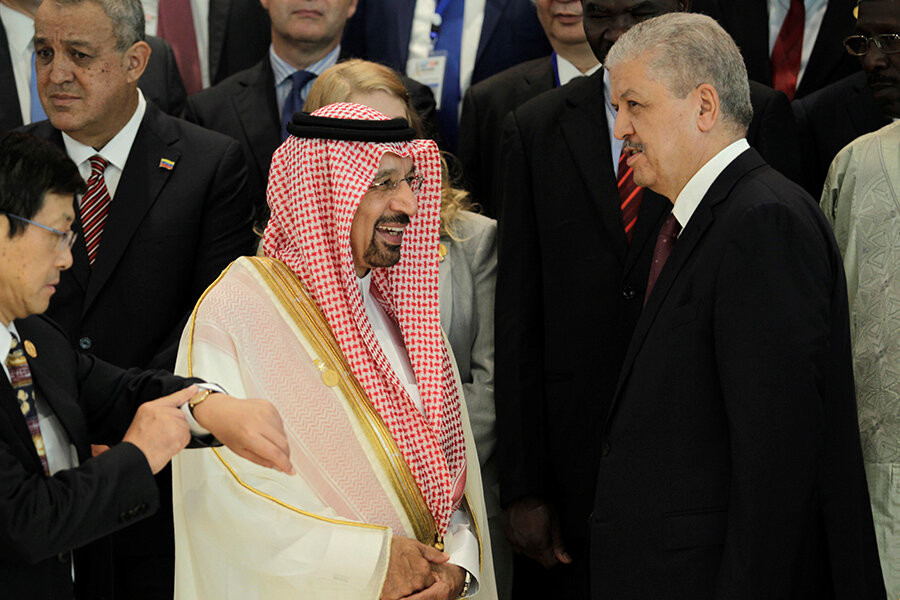Is Saudi Arabia serious about bringing back high oil prices?
Loading...
In the global tug of war over how to bring world oil markets back into balance, Saudi Arabia just ceded a little ground.
After nearly two years of letting market forces (in other words, low oil prices) bring down a glut in production, the kingdom agreed this week to support a deal to cut production. The Organization of the Petroleum Exporting Countries (OPEC) came up with the outlines of an agreement on Wednesday. The cartel says it wants to trim its production by up to 900,000 barrels a day, beginning in about two months.
The agreement – if it really is struck – could have far-reaching effects. It could drag down already weak economic growth worldwide by boosting what Americans and most of the world’s motorists pay at the pump. It throws a possible lifeline to beleaguered OPEC members, especially Venezuela, Nigeria, and Libya, which have foundered in the era of low oil prices.
Or it could do none of these things. There’s deep skepticism that OPEC will be able to agree on new production quotas, especially given the tension between Saudi Arabia and Iran. World oil markets, which surged on the cartel’s announcement Wednesday, were quiet on Thursday as traders and analysts assessed the cartel’s likely path.
Perhaps more intriguing is the strategy of the Saudis themselves. Having now made noises about controlling production and boosting prices, it could go further to singlehandedly enforce some real discipline, according to some analysts. But others suggest that newest move is temporary, with Riyadh happy in the long term to let the oil glut work itself out without OPEC intervention.
Which vision the Saudis pursue will have a major influence on oil prices in coming years.
Two years ago, when fracking of oil surged in the United States, Saudi Arabia let it be known that it would not cut production to support prices, as it had in the past. So prices plunged from $105 to $44 per barrel by early 2015. Every time an OPEC nation suggested a production cut, the kingdom would demur. Its strategy was to let low prices force high-cost producers (especially those in the US) out of business so the world would again become more reliant on Saudi oil.
What the Saudis failed to foresee was how low oil prices would go. West Texas Intermediate crude, a benchmark for US prices, briefly dropped below $27 a barrel earlier this year. Non-OPEC producers have also proven resilient. Russia, despite sanctions, is boosting its production. The US rig count, though down nearly 80 percent from its peak, has begun moving back up as producers slash costs and find ways to turn a profit.
But the Saudis are facing a revenue squeeze, announcing 20 percent salary cuts for the public sector. Earlier this year, Saudi Arabia signaled it would accept an agreement to cut production if all OPEC nations participated. At the OPEC meeting in Algeria this week, the Saudis reportedly backed off the demand for everyone, such as Iran, to make big cuts.
“The move marks a major turnaround for Saudi Arabia and likely reflects the mounting economic challenges facing the Kingdom in the current price environment,” RBC Capital Markets says in a research note released Thursday.
Skepticism about the deal runs deep because the agreement announced Wednesday represents the first, and easiest, step. At its meeting in Algeria, OPEC agreed to cut overall production to 32.5 million barrels per day (b.p.d.) – some 200 million to 900 million less than current production, depending on who is counting. But OPEC won’t decide on production quotas for each OPEC nation until its next meeting Nov. 30.
“That’s a tall order,” Jim Burkhard, head of oil market analysis at consulting firm IHS, writes in an e-mail. “Individual quota allocations have always been contentious among OPEC members, and there is no evident reason for this to be easier this time around. “
He and other energy analysts expect the Saudis will make the bulk of the cuts themselves. Riyadh could accomplish much or all of its reduction simply by allowing its seasonal production drop to occur this winter, Mr. Burkhard says.
But that role was something Saudi Arabia has been trying to escape. According to some analysts, the Saudis have not deviated from their long-term goal of letting the marketplace handle the glut. Despite the resilience of some non-OPEC producers, production has fallen and investments in future oil production have plunged. At some point, that fall in production will eliminate the glut and prices will go back up.
“We're now heading into the third year of the decision to let the market determine [prices],” says Guy Caruso, senior adviser to the energy program at the Center for Strategic & International Studies in Washington. “There certainly has to be a certain anxiety and concern about how long things are taking. [But] I don't think they're at that point now where they're saying: ‘OK, this isn't working. Let's try something else.’ ”
Instead, by making noises about a production cut, he adds, the Saudis can talk oil prices up a bit as they wait for market forces to bring production back into balance.






